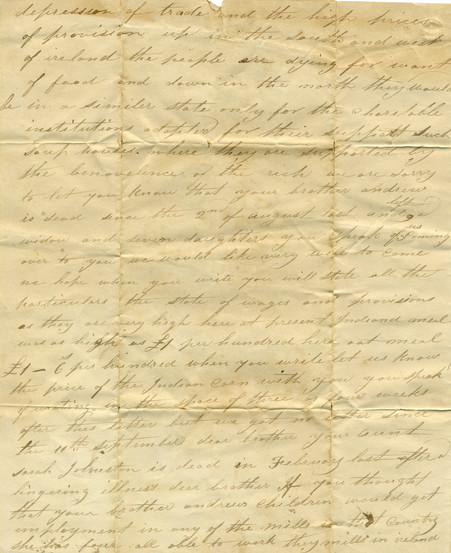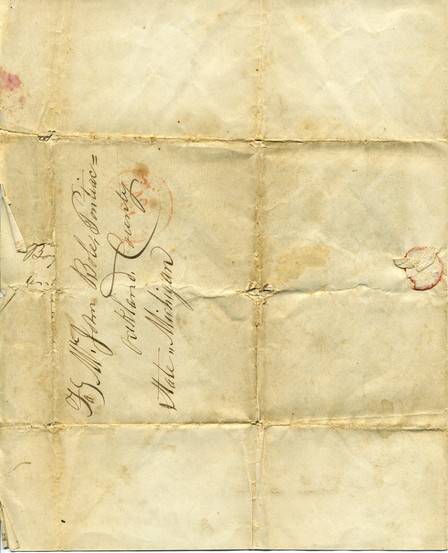The Dugan Family Letters: Tales of the Great Famine
- Local History Collection

- Sep 10, 2020
- 3 min read
Updated: Mar 17, 2022
The Irish Potato Famine, also known as the Great Hunger, began in September 1845 when farmers realized the leaves on their potato plants were starting to wilt and turn black. In commemoration of the 175th anniversary of this early blight that eventually led to mass starvation across Ireland, we look back at the letters of Roslyn residents John Bole and his sister Ann Jane (Bole) Dugan, which are contained within the Local History Collection. The earliest letters were sent between Belfast, where Ann Jane lived with her family, and Michigan, where her brother John was residing after emigrating from their native country some years earlier. Dated from April of 1847, which was considered one of the deadliest years of the Famine, this first letter from Ann Jane to John describes a country in crisis:
But Ireland at present is in a very distressed state owing to the depression of trade and the high prices of provisions. Up in the south and west of Ireland the people are dying for want of food and down in the north they would be in a similar state only for the charitable institutions adopted for their support.
Ann Jane reminds her brother that he had spoke of the possibility of she and her husband, Samuel, coming to America, stating: "We would like very well to come. We hope when you write you will state all the particulars..." This initial sign of turmoil was augmented by a later letter from September 1848 in which Ann Jane laments over the state of things:
…I need offer to describe to you the situation in poor Ireland, as this is the third year that the potato crop has rotted in the ground and no trade. The mills standing idle and some on half time, and wages down and all appearance of provisions being high in price… Dear brother, there is no prospect for the working man in this country, as there is no employment and there is nothing in this world would be happiness to me and my husband as to see you and to be with you in that country…. I depend dear John on your answer as soon as possible and you may depend on it that we will not be long in this country, as I assure you that Samuel is a hard working, carefull man and no whiskey is drank by any of us...
The honorable husband she describes, Samuel Dugan, would indeed travel with his wife and children to America in July of 1853 and take up residence in the town where Ann Jane's brother was now living, Roslyn, NY. Several months before their arrival, John had written her a letter from Roslyn dated April 22, 1853 that implored them to finally brave the journey:
…I have now a house all ready for you, if you come this Spring. I hope you will not delay in coming.
Sending the family 20 pounds sterling to aid their passage, John Bole’s sponsorship of his sister and her family allowed them to enter the country and settle in Roslyn.
Here we see the digitized letters that were saved by the Dugan family for 165 years before they were donated to our collection:
Listed in the 1860 census as a farmer, and in 1880 as a stonemason, Samuel Dugan became the master mason for the old railroad tunnel overpass at Roslyn Road that was demolished in the 1940s. It is also believed that he built the Italianate style house at 148 Main Street where the family long resided.
Though the Dugan Family survived Ireland’s Great Famine long enough to travel to America, their letters are evidence of the troubled times endured by the Irish people during its deadly height. Residual effects were no doubt being felt when the Dugan’s left the country, just as so many others had done in the years prior. Reflecting on this dark piece of history, it is important to acknowledge the harrowing experiences of American immigrants who travel to this country to escape perilous conditions and economic strife. Whether crossing by land or sea, it is the will to take a potentially fatal journey with the hope of attaining a decent quality of life that forms the American ideal of tenacity and perseverance in the face of adversity.
Further commentary on the letters and details on the Bole/Dugan Family can be found in the March/April 2010 newsletter article written by former Bryant Library archivist Myrna Sloam. The family’s story continues in Part II of the article, which appeared in the May/June 2010 newsletter.


























I love all of these articles and little stories about Roslyn. So interesting to hear about these families. I am very interested on the topic of Immigration.